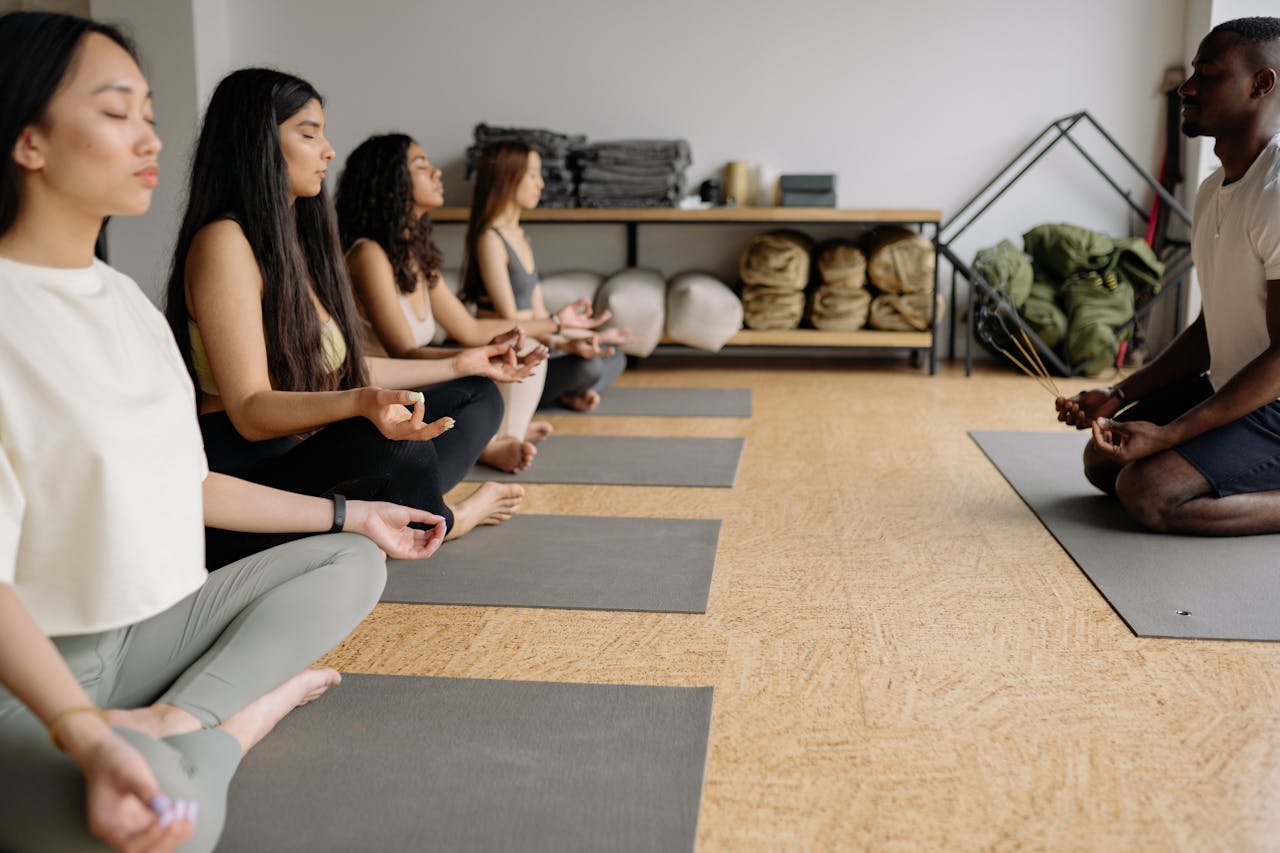
Table of Contents
Meditation is a simple practice, yet it is not easy and takes great skill to master. Because of this, many people feel that they do not have the patience that meditation requires, often discouraging them from getting involved in mindfulness exercises. This is where guided meditation offers a simple solution. Jason Stephenson is a popular creator of guided meditations known for his calming voice and gentle music.
Guided meditation is a process where participants meditate following the instructions given by a professional teacher. It is unique from regular meditation by incorporating the audio element, often narrated by an experienced teacher.
What is Guided Meditation?
Guided meditation involves conventional aspects of meditation practice, such as deep breathing, visualization, and attention to sound. The idea is to quiet the brain so the practitioner can rest and relax while in an awake state.
One will let go of distracting thoughts during the practice and tune in to the present moment with open awareness. Most meditations last between 10 to 25 minutes, providing a variety of lengths to suit different needs.
Meditation often takes practice and does not come naturally. The mind is a thought machine, making it very difficult for the mind to quiet and stop thinking. This makes it hard to let go of negative feelings, but when we do, we can gain a better perspective on situations in our inner life when we are in a state of stress. One short guided practice will allow practitioners to feel calm and relaxed, equally important as getting regular exercise or fitness.
Guided meditations give practitioners the essential tips and fundamentals to practice meditation independently while offering vital skills in individual practices.
The narrated guidance provides us with a healing space for deep relaxation. Here, we can reflect on our feelings through the teacher’s guidance to access a calm and relaxing state.
Benefits of Guided Meditation
There are extensive benefits to a guided meditation that support mental and physical health.
Some of the many benefits include:
-
Improves mood
-
Supports focused attention
A good night’s rest is essential to mental and physical health, and guided meditation is one of the most common and helpful solutions for those who have trouble sleeping at night. There are specific guided meditations that are precisely orchestrated to bring people into a deep state of rest. It takes minimal effort and allows new practitioners to develop their mindfulness skills.
Practicing guided meditations that adhere to one’s goals in life can help people manifest a better outlook on the world and be a better version of themselves. Whether to be happier, quit smoking, or accomplish another personal goal, guidance can help one achieve growth.
Types of Guided Meditation
There are many different types of guided meditation practice. Teachers can turn most foundational meditation exercises into guided meditations, making them highly flexible. Here are three of the most common guided meditation styles that people practice:
Walking meditation is a form of meditation guided to blend physical activity with mindfulness practices. It helps individuals connect with their bodies and minds while engaging in exercise, enhancing focus, reducing stress, and fostering a positive mindset.
Walking meditation
Walking meditation is an exercise where one draws their attention inward while their physical body moves and their mind wanders. The exercise improves awareness of surroundings, helps one stay in the present moment, and can reduce stress and relieve past worry.
Yoga Nidra
Yoga Nidra, also known as yogic sleep, is a guided meditation that brings the practitioner into a deep state of consciousness that sits on the border between waking and sleeping. Practitioners access this state by paying attention to the body through a body scan, breathing, guided imagery, and other mindfulness meditation techniques.
Body scan meditation
Body scan meditation is a simple practice involving narrowing focus to each part of the body and systematically noticing the sensations from feet to head. This brings self-awareness to each body part and exposes pains, tension, and other lingering feelings.
Visualization Meditation
In this mindfulness meditation, one will focus on something specific, hold it in their mind, and imagine the outcome of this becoming a reality. This is an effective practice to help people reach their goals through guidance and manifestation.
In addition to these styles, other forms of guided meditation include loving-kindness meditation, visualization meditation, gratitude meditation, and many more. Begin meditating with an open mind to find the mindfulness meditation exercise that best resonates with you.
Deepening Your Guided Practice
Deepening your guided practice involves taking your meditation to the next level by incorporating various techniques and strategies to enhance your experience. Here are some tips to help you deepen your guided practice:
-
Start with a Clear Intention: Before you begin your guided meditation, take a moment to reflect on what you hope to achieve. This could be as simple as reducing stress or improving focus. Having a clear intention will help you stay focused and motivated throughout your practice.
-
Find a Quiet and Comfortable Space: Identify a quiet and comfortable space where you can meditate without distractions. This could be a dedicated meditation room or a peaceful spot in your home.
-
Use a Guided Meditation App: Consider using a guided meditation app like Headspace or Calm to help you get started. These apps offer a variety of guided meditations led by experienced teachers, and they can be a great way to deepen your practice.
-
Practice Regularly: Consistency is key when it comes to meditation. Try to practice at the same time every day, so it becomes a habit.
-
Focus on Your Breath: Paying attention to your breath is a great way to calm your mind and bring yourself into the present moment. Try to focus on your breath throughout your meditation practice.
-
Use Body Scan: Body scan is a technique where you bring your attention to different parts of your body, starting at your toes and working your way up to the top of your head. This can help you release tension and relax.
-
Try Loving-Kindness Meditation: Loving-kindness meditation involves cultivating feelings of love and compassion towards yourself and others. This can be a powerful way to deepen your practice and cultivate a sense of peace.
-
Experiment with Different Types of Meditation: There are many different types of meditation, including mindfulness meditation, transcendental meditation, and movement meditation. Experiment with different types to find what works best for you.
-
Seek Guidance from an Experienced Teacher: Working with an experienced teacher can be a great way to deepen your practice. They can offer personalized guidance and support to help you overcome challenges and achieve your goals.
-
Be Patient and Persistent: Deepening your guided practice takes time and effort. Be patient and persistent, and remember that it’s okay to encounter challenges along the way.
By following these tips, you can deepen your guided practice and take your meditation to the next level. Remember to always be patient and kind to yourself, and don’t be afraid to seek guidance from an experienced teacher if you need it.
Frequently Asked Questions on Guided meditations
How to practice guided meditation
People can practice guided meditation anywhere, anytime. Whether in the morning, at work, or in the evening before sleep, guided meditation content is highly accessible and can accommodate people's unique schedules as it is attainable on one's mobile device. Plugging into a meditation podcast makes it easier to practice guided meditation. If one's browser does not support the audio element, applications such as Headspace or Calm offer a great solution.
What is self-guided meditation?
In many ways, self-guided meditation is the opposite of guided meditation for more experienced practitioners. It clears negative energy while supporting inner peace and positive thinking, focusing one’s attention to clear the mind.
During self-guided meditation, the practitioner will begin by creating a healing space for themselves and setting an interval bell. They may wish to turn on some meditative background sounds to listen to and focus on. Be sure to go in with a plan, whether by repeating a mantra, focusing on your breath, or practicing visualization.
Can guided meditation be dangerous?
Although rare, some case studies have highlighted adverse side effects from meditation practice. These studies outline that it can increase depression, anxiety, and psychoses. Even though this is true in rare cases, there are minimal studies that looked into the issue in depth.
What app for guided meditation?
Many apps provide extensive access to different guided meditations and finding an app that best suits your needs is essential.
For paid subscription, here are some of the more popular apps to sign up on:
-
Calm
-
Headspace: Meditation and Sleep
-
Ten Percent Happier
For free app downloads, there are the most commonly used options to sign up for:
-
Smiling Mind
-
Insight Timer
-
MyLife Meditation
Many people also choose to sign up for a free trial to see which application best suits them.
References
Guided meditation: A regimen for mental health
The Blooming of a Lotus: Revised Edition of the Classic Guided Meditation
Can Meditation Cause You Harm? | Greater Good.
Guided meditation: A regimen for mental health
Disclaimer
The contents of this article are provided for informational purposes only and are not intended to substitute for professional medical advice, diagnosis, or treatment. It is always recommended to consult with a qualified healthcare provider before making any health-related changes or if you have any questions or concerns about your health. Anahana is not liable for any errors, omissions, or consequences that may occur from using the information provided.

By: Meriah McCauley
Meriah McCauley is a leading voice in holistic healing, known across North America for her expertise in chakra balancing, spiritual alignment, and energy-based wellness. Her work bridges the art and science of mind-body healing, shaped through years of study, practice, and mentorship. Meriah deepened her understanding of spiritual anatomy and the chakra system under the guidance of her guru, Dr. Don Stapleton, during her immersive training in Costa Rica. She later earned her Master’s degree in Psychology from Columbia University, specializing in Spirituality and the Mind–Body connection, which continues to influence her integrative approach. Today, she supports individuals and practitioners through coaching, yoga teacher trainings, chakra-focused education, and Holotropic Breathwork for personal transformation. Meriah is dedicated to helping others develop emotional clarity, energetic balance, and spiritual resilience—and she remains committed to guiding anyone seeking a deeper, more meaningful connection with themselves.